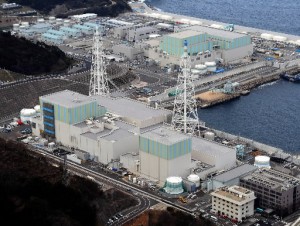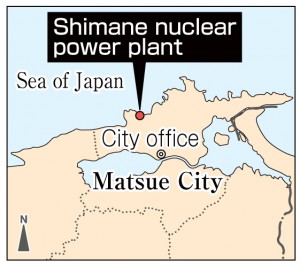Chugoku Electric Power Company decides to decommission No. 1 reactor at Shimane nuclear power plant
Mar. 27, 2015
by Naoya Kawai, Staff Writer
At a special board meeting on March 18, the Chugoku Electric Power Company made the decision to decommission the No. 1 reactor at the Shimane nuclear power plant in Matsue on April 30 and submitted a notice of decommission to the Ministry of Economy, Trade and Industry. The reactor has been in operation for 41 years with an output capacity of 460,000 kilowatts. This is the first time that the company will decommission a nuclear reactor. Tomohide Karita, the president, and company executives visited local government offices in the city of Matsue, Shimane Prefecture, and elsewhere to inform officials of this decision.
After the accident at the Fukushima Daiichi (No. 1) nuclear power plant, the Nuclear Regulation Authority (NRA) limited the operating period of nuclear power plants to 40 years in principle. For exceptions, in which the operating period can be extended for an additional 20 years, reactors must undergo a “special inspection” that is more stringent than the normal inspection.
The Chugoku Electric Power Company studied both options, decommissioning the No. 1 reactor or extending its operating life. But because a significant investment would be required to put in place safety measures to extend this operating period, and the fact that this reactor has only one-third of the output capacity of newer reactors, the company concluded that maintaining the No. 1 reactor would not be profitable. The decision to decommission the reactor was then made in line with a new accounting rule introduced this month which enables a nuclear power station to avoid a sharp drop in property value, even in the case of decommissioning a reactor.
The company estimates it will cost 37.8 billion yen to decommission the No. 1 reactor. It has already reserved 34.1 billion yen for this purpose and will subsequently set aside the remaining 3.7 billion yen. However, the final tally for decommissioning the reactor will not be known until the actual costs have been totaled.
Over the next six months, the company will develop a detailed plan for decommissioning the reactor, and begin this work after gaining the agreement of local government officials and the approval of the NRA.
On the same day, Mr. Karita visited Zenbee Mizoguchi, the governor of Shimane Prefecture, and Masataka Matsuura, the mayor of Matsue, and shared the company’s decision to decommission the reactor. “It will take 30 to 40 years to complete this project,” he explained. “We will carry out the work while making safety our top priority.”
Mr. Mizoguchi said, “A thorough description of the decommissioning plan is needed, with the involvement of the other adjacent municipalities. I would like to determine whether I can give approval for the start of decommissioning work in two phases: before the application is submitted to the central government and after receiving the results of that application.” Regarding the disposal of nuclear waste generated by the decommissioning work, Mr. Matsuura made a request by saying, “Our citizens won’t accept the storage of spent nuclear fuel on the grounds of the nuclear plant for a long time.”
In addition, executives from the Chugoku Electric Power Company visited the mayors of Izumo, Yasugi, Unnan, Yonago, and Sakaiminato, and Shinji Hirai, the governor of Tottori Prefecture, and reported on the company’s decision to decommission the reactor. These cities and a part of Tottori Prefecture are located within 30 kilometers of the Shimane nuclear power plant.
Keywords
No. 1 reactor at Shimane nuclear power plant
The Shimane nuclear power plant began operating in March 1974 as the first domestic nuclear plant built by a Japanese manufacturer. The No. 1 reactor is a light-water (boiling-water) reactor, the same type as the stricken reactors at the Fukushima Daiichi (No. 1) nuclear power plant, and has an output capacity of 460,000 kilowatts. Due to inadequate inspections of the reactor equipment, operations were halted in March 2010. Though regular inspections began to be carried out in November 2010, the reactor has not been in service for nearly five years.
(Originally published on March 19, 2015)
At a special board meeting on March 18, the Chugoku Electric Power Company made the decision to decommission the No. 1 reactor at the Shimane nuclear power plant in Matsue on April 30 and submitted a notice of decommission to the Ministry of Economy, Trade and Industry. The reactor has been in operation for 41 years with an output capacity of 460,000 kilowatts. This is the first time that the company will decommission a nuclear reactor. Tomohide Karita, the president, and company executives visited local government offices in the city of Matsue, Shimane Prefecture, and elsewhere to inform officials of this decision.
After the accident at the Fukushima Daiichi (No. 1) nuclear power plant, the Nuclear Regulation Authority (NRA) limited the operating period of nuclear power plants to 40 years in principle. For exceptions, in which the operating period can be extended for an additional 20 years, reactors must undergo a “special inspection” that is more stringent than the normal inspection.
The Chugoku Electric Power Company studied both options, decommissioning the No. 1 reactor or extending its operating life. But because a significant investment would be required to put in place safety measures to extend this operating period, and the fact that this reactor has only one-third of the output capacity of newer reactors, the company concluded that maintaining the No. 1 reactor would not be profitable. The decision to decommission the reactor was then made in line with a new accounting rule introduced this month which enables a nuclear power station to avoid a sharp drop in property value, even in the case of decommissioning a reactor.
The company estimates it will cost 37.8 billion yen to decommission the No. 1 reactor. It has already reserved 34.1 billion yen for this purpose and will subsequently set aside the remaining 3.7 billion yen. However, the final tally for decommissioning the reactor will not be known until the actual costs have been totaled.
Over the next six months, the company will develop a detailed plan for decommissioning the reactor, and begin this work after gaining the agreement of local government officials and the approval of the NRA.
On the same day, Mr. Karita visited Zenbee Mizoguchi, the governor of Shimane Prefecture, and Masataka Matsuura, the mayor of Matsue, and shared the company’s decision to decommission the reactor. “It will take 30 to 40 years to complete this project,” he explained. “We will carry out the work while making safety our top priority.”
Mr. Mizoguchi said, “A thorough description of the decommissioning plan is needed, with the involvement of the other adjacent municipalities. I would like to determine whether I can give approval for the start of decommissioning work in two phases: before the application is submitted to the central government and after receiving the results of that application.” Regarding the disposal of nuclear waste generated by the decommissioning work, Mr. Matsuura made a request by saying, “Our citizens won’t accept the storage of spent nuclear fuel on the grounds of the nuclear plant for a long time.”
In addition, executives from the Chugoku Electric Power Company visited the mayors of Izumo, Yasugi, Unnan, Yonago, and Sakaiminato, and Shinji Hirai, the governor of Tottori Prefecture, and reported on the company’s decision to decommission the reactor. These cities and a part of Tottori Prefecture are located within 30 kilometers of the Shimane nuclear power plant.
Keywords
No. 1 reactor at Shimane nuclear power plant
The Shimane nuclear power plant began operating in March 1974 as the first domestic nuclear plant built by a Japanese manufacturer. The No. 1 reactor is a light-water (boiling-water) reactor, the same type as the stricken reactors at the Fukushima Daiichi (No. 1) nuclear power plant, and has an output capacity of 460,000 kilowatts. Due to inadequate inspections of the reactor equipment, operations were halted in March 2010. Though regular inspections began to be carried out in November 2010, the reactor has not been in service for nearly five years.
(Originally published on March 19, 2015)









